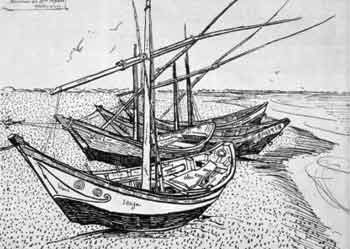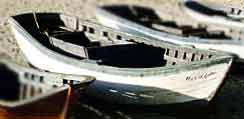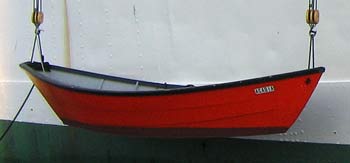
Dories

What is a Dory?
Information on dories is varied and contradictory. This is because there are many different styles of dories and boatbuilders have adapted the dory for local conditions.
The name dory usually brings to mind the Grand Banks Dory, with its straight sides, flat bottom, narrow transom and characteristic straight bow. Relatively Light and simple to build and stackable they were used as fishing dinghies.
There are many types of dory type boats in the world. VanGogh left us a drawing of dory like boats. Another example is the Portuguese fishing boats that have very similar lines.
john Gardener in his book The Dory Book, defines a dory as " A dory is a flat-bottomed boat, with sides and bottom planked lengthwise and with no keel structure other than the bottom planking"

Various designs of dories show more or less rocker (curve) on the bottom depending on the use. Portuguese fishing boats show lots of rocker while some of the grand banks dory considerably less. Rocker allows a boat to pivot and be more manoevrable. Beaching dories and driftboats show a lot of rocker. Flatter boats track better.
The narrower transom, "tombstone" shaped, is also a typically "dory-ish" feature.
Dories were cheap and quick to make and as in the case of the grand banks dory stackable. The mother ship would go out with large piles of dories on deck. When they reached the fishing grounds the dories would be launched. At the end of the day the dories would be brought back on board.

Grand Bank Dories were notoriously unstable and unpleasant to handle unless they carried some weight. They then settled down. It is not surprising that modern interpretations of the dory are designed to improve stability.
Dories can vary a lot in shape. It seems that every locality has a brand of boat they call a dory. Various designs evolved depending on the use the dory was to be put to and the nature of the water in the area. Some dories are hardly what we would consider as dories at all. They have curved sides with only the smallest or no flat bottom. The transom has also widened probably in an effort to stabilize the boat. Because the bow and stern are narrow you cannot step in this area easily. In my little Skerry which is pointy on both end going to the very bow or stern is difficult and the boat goes down quite a lot. This lifts the opposite end (since the boat is very light) and waves can catch.
Michael Storer has a very interesting analysis of dories. It's well worth reading his article.
Modern rowing dories are lighter than their traditional counterparts. This is an advantage in many ways but it makes them subject to more windage effect. It also makes weight distribution more critical.
Video of a Portugese fishing boat using grand bank style dories 1960's. about 10 minutes.
Another Video on Portugese cod fisherman, much older than the one above. Many shots of dories being used. Narrated in Portugese but really interesting.
Grand Banks Dory
Thinking about Grand Banks Dory make you want to break out in a rousing chorus of "squid jigging ground". The legend is dear to modern boaters but the reality of these dories was harsher.
They were tricky boats to handle until you had half a load of fish. Luckily they were rarely empty. Going out the boat would have fishing gear and bait, coming in they would have fish. Their great claim to fame was that they were quick and cheap to make and stackable. This was a great advantage.

I once rode in an empty fishing dory. It tended to roll to one side if your weight went too far out, then it stopped short of tipping and it was quite hard to push it any further. Because the bow and stern are narrow it makes a big difference if the weight is more or less forward. Less so when there is weight in her but still more than in boats with wider ends.
Stability of boats is a function of several factors including length to breath ratio and weight. A great deal has been written on boat stability
St Pierre Dory
St Pierre Dories are large often motorized dories. They hail from St Pierre et Miquelon islands off Newfoundland where they were commonly seen. Their size and weight make them a reliable and stable boat. The rowing version has higher sides and more height to the bow and stern.
Modern plywood versions are made and some have been reported tender if not loaded down, as some dories often are. Builders often add a small cabin.
Video of a 9 plus hour row from St Pierre to Grand Banks by Dory These are rowed traditional St Pierre Dories. The shape is quite distinct with high sides and ends to accommodate the large waves where they are used. Interesting Video. In the background there are motorized versions.
Beach Dories
Beach dories were fishing boats developed for launching from the beach. According to Gardner the beach dories evolved from wheries. They are rarely shorter than 14 feet and very rarely seen larger than 20 ft.. The narrow transom, sometimes called tombstone, allows the boat to row in following and breaking waves without swamping. The Beach dory has slightly rounder curves than the Great banks dory. Swampscott dories are still being built and plans are readily available in stitch and glue construction.
Fabulous photo of a surf dory on a wave.
Swampscott Dories
At first glance these dories do not seem like dories but a closer look will show the flat bottom, narrow transom and the the dory profile. Where they differ is in the curve of the sides. Where the grand bank dories were flat sided with few boards, the swampscott dory is curvier and has more strakes. Selway Fisher offers these plans for his interpretation of the Swampscott dory.
Some swampscott dories have so much curve in the sides and such narrow bottom that the boat becomes a round bottom boat for all intents and purposes.
Swampscott dories have a long history, first as fishing boats but also as pleasure sail boats.
Chesapeake Light Craft presents a time lapse photography of their Northeaster Dory being built at one of their sessions.

Drift Dories or Mackenzie River dories
These are a peculiar adaptation of the dory design. These rowing dories are made wider and with greater rocker than other types of dories. They are used in fast rivers with rapids. The high rocker and wider design makes them more stable as they bounce over rapids. They have very narrow transoms.
Exciting Video of Drift Dory going down impressive rapids.Dory Size
An interesting quirk of the dory world is that the size of the dory refers to the bottom plank. Thus a 15 foot dory might well be 19 feet long overall. This measuring is not universally used in new designers so check your size carefully so you won't end up with a boat 4 feet longer than you expected.
If you plan to sometimes have a second rower you will need to carefully place your rowing positions. One for solo, and 2 different ones for doubles. Because the boat narrows significantly front and back, it makes rowing less comfortable because the beam is not wide enough at the bow and stern.
Mention the word Dory and you immediately get an argument. There is a great deal of controversy as to the tenderness vs stability of dories. Not all dories are created equal and not all traditional designs translate to pleasure boats gracefully. If you plan on building one do your research otherwise you might find yourself looking for 200 pounds of cod to stabilize your dory for your Sunday afternoon row.
The Dory Book by John Gardner, Free to Read online, pdf
email me if you find mistakes, I'll fix them and we'll all benefit: Christine
Dory Links

Gavin Atkin's book has instructions for building "Doris the Dory":[Ultra-Simple Boat Building: 18 Plywood Boats Anyone Can Build] (By: Gavin Atkin) [published: November, 2007]

Hannu builds Bolger Light Dory Well worth reading if you are considering building a dory. He gives a report on how she handles with one and two rowers.
Instructions on how to build the Gloucester light dory from Dynamite Payson, who worked closely with Philip Bolger designs.

The Dory Model Book: A Woodenboat Book
Dory Boat Wooden Model Construction Kit 3D Woodcraft by YongModeler

PORTER-CABLE PCE345 6-Amp Orbital Jig Saw

West System Starter Kit 2: 1 Gal 105B, 1 Qt 205B, 300 Mini Pumps

888805 Caviness Lam with Grip Oar 7 Foot,

PLUSINNO Telescopic Fishing Rod and Reel Combos FULL Kit, Spinning Fishing Gear Organizer Pole Sets with Line Lures Hooks Reel and Fishing Carrier Bag Case Accessories (1.8M 5.91Ft Fishing Full Kit) …

Spira has plans for many types of dories.
Looking at a YouTube video of a St Pierre Dory on Dry land.
Dory landing on beach YouTube video
A thompson Dory from Salt Pond Rowing
Willie Boats Drift Dories.
Free Dory Plans from Mechanix Illustrated reproduced by Swenson.com
My Boat Plan links
My Boatbuilding resources
http://youtu.be/pyV5JebbYc0 Video of French Dories being rowed.Marine Plywood Grades used in Boatbuilding
Stitch and Glue boatbuilding method.
How to decide what kind of boat to build
The Dory Shop has been making Traditional Lunenburg Dories (Nova Scotia) for 100 years, also offering dory building classes.
My article on leathering oars
Take apart and folding boats.
One Sheet Boats including links to several one sheet free plans.
Small Print
I don't claim to be an expert in dories. If you want to build one do your homework first.